This article was updated in August 25, 2025 with new products and information by Mark S. Taylor
A few years ago, I pulled the cover off a 1965 Mustang that had been sitting in a dusty garage for decades. The potential was palpable. If you own a classic car, you know that feeling—it’s more than just a vehicle; it’s a time capsule on wheels, a piece of history you can touch.
But that passion comes with a unique set of challenges, especially when it comes to auto repair for classic cars. Unlike a modern vehicle where parts are a click away, you’re not just fixing a machine; you’re preserving a story. From hunting down rare components to the specific skills needed for a carburetor rebuild, the journey can feel overwhelming.
I’ve navigated that journey, and I’m here to share what I’ve learned. In this comprehensive guide, we’ll dive into everything you need to know to keep your vintage car in top shape, from common engine issues to finding a trustworthy mechanic. Let’s get under the hood and make sure your classic gets the care it truly deserves.
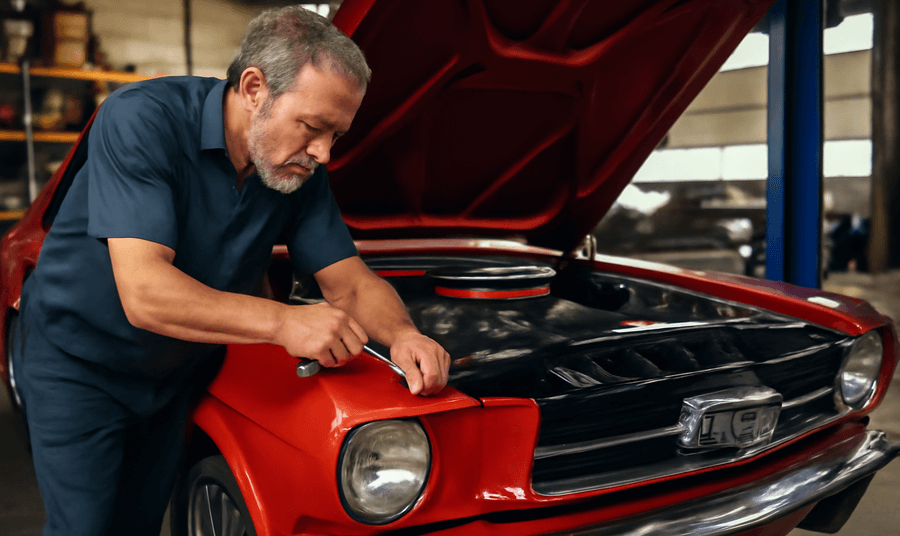
Contents
What Defines a Classic Car and Why Specialized Repair Matters
When we talk about auto repair for classic cars, it’s important to understand what makes a car “classic.” Classic cars are typically 25+ years old, while antique cars are over 45 years old. Vintage cars are even older, often from the pre-1930s. Muscle cars, like the 1960s Mustang, are special for their high performance and unique repairs.
Repairing these cars isn’t the same as fixing newer vehicles. Old car parts are harder to find, and sometimes, they’re expensive. For example, classic cars often use carburetors, while most modern cars use fuel injection systems. These parts need special attention and care.
Why does this matter? Proper repair keeps a car running well and helps protect its value. A well-restored classic car can actually become more valuable over time. According to Hagerty’s Classic Car Price Index, the classic car market grew by nearly 10% in 2020. That’s a solid sign that well-maintained cars are worth the effort.
I had a client with a 1967 Camaro that hadn’t been restored. It ran, but after a few drives, it broke down. If we’d restored it earlier, those breakdowns could have been avoided, saving money in the long run.
Repairs on classic cars also improve safety and make driving more enjoyable. Whether it’s engine repair or fixing a carburetor, proper work ensures these cars last longer and stay safe on the road.
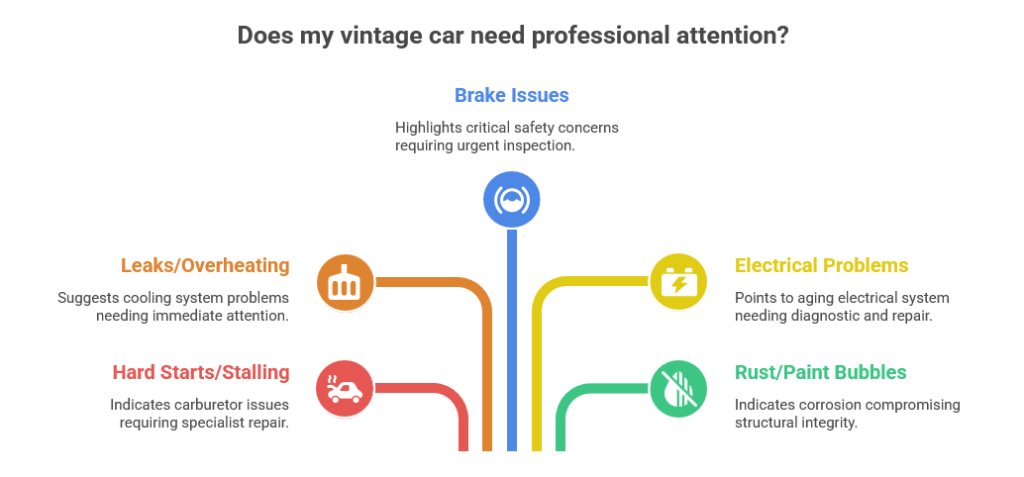
Key Signs Your Vintage Car Needs Professional Attention
Your classic car communicates in its own language—through sounds, smells, and handling. Ignoring its whispers can lead to a roar of expensive problems. Based on my years of experience in auto repair for classic cars, here are the most common signs that it’s time to see a specialist.
1. Hard Starts, Stalling, or Rough Idling
If your car struggles to turn over or stalls at a stoplight, your carburetor is often the prime suspect. Unlike modern fuel injection, classic carburetors rely on a precise mechanical mix of air and fuel. Over time, gaskets wear out and passages get clogged.
- Real-World Example: A client brought in his 1970 Mustang that he could barely keep running. A professional carburetor rebuild completely transformed it, giving it the smooth, reliable power it had when it was new.
- What to Do: Don’t let this issue linger. A poorly performing carburetor can lead to poor fuel economy and even engine damage. Seek out a mechanic who specializes in this kind of vintage technology.
2. Puddles Under the Car or a Spiking Temperature Gauge
Visible leaks or an engine that’s running hot are urgent red flags. Coolant leaks from brittle hoses or a failing radiator can quickly cause catastrophic engine damage.
- The Culprit: These issues often trace back to the cooling or exhaust systems. In the world of auto repair for classic cars, we frequently see original radiators that can no longer keep up.
- What to Do: If you see green, red, or brown fluid, or if your temperature gauge enters the red zone, pull over safely. A simple hose replacement is a minor fix; a warped cylinder head is a major expense.
3. Spongy, Squealing, or Fading Brakes
There is no system more critical to your safety than your brakes. Classic car brake systems, especially those with drum brakes, require regular inspection and adjustment.
- Real-World Example: I recently performed a classic car brake service on a ’57 Chevy where the owner complained of a “soft” pedal. His brake pads were worn down to the metal. He was incredibly lucky a serious failure didn’t occur on the road.
- What to Do: Any change in brake feel—squealing, grinding, or a pedal that feels spongy—means you should stop driving the car and have it inspected immediately.
4. Dim Headlights or Erratic Electrical Behavior
Flickering gauges, dimming lights, or a radio that cuts out are classic signs of an aging electrical system. Wires in vintage cars can become brittle and frayed over decades, leading to poor connections or dangerous shorts.
- The Culprit: The issue could be a weak alternator, a failing battery, or the old wiring itself. The electrical systems in these vehicles are far simpler than modern cars, but also more fragile.
- What to Do: A classic car mechanic can perform a full diagnostic to trace the source of the problem, ensuring your car is both reliable and safe.
5. Bubbling Paint or Visible Rust
One of the biggest enemies of vintage steel is rust. What starts as a small bubble in the paint can be hiding significant corrosion underneath.
- Why It Matters: Rust isn’t just a cosmetic issue; it can compromise the structural integrity of your car’s frame and body panels. This is a core part of auto repair for classic cars that cannot be ignored.
- What to Do: At the first sign of bubbling or flaking paint, have a bodywork specialist investigate. Catching rust early can be the difference between a small patch job and a massive, expensive restoration project.
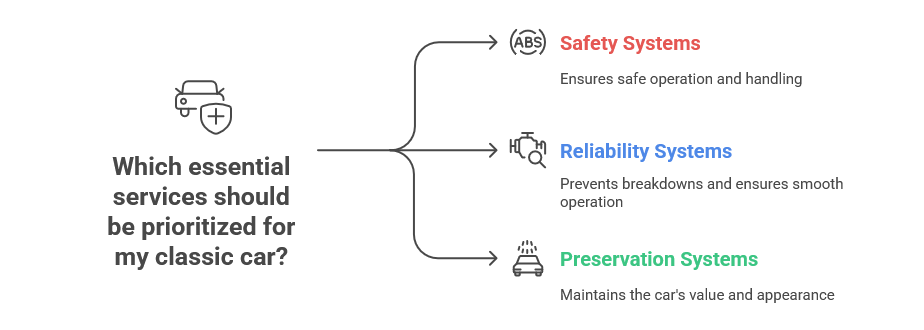
The Essential Services Your Classic Car Needs
A classic car is a symphony of interconnected systems, and keeping it in tune requires specialized knowledge. Neglecting one area can easily cause problems in another. As a specialist in auto repair for classic cars, I’ve learned that focusing on a few key areas can prevent the most common and costly issues. Let’s break down the essential services your vintage vehicle needs to stay on the road and out of the shop.
1. The Powertrain: Engine & Transmission Repair
The engine and transmission are the heart and soul of your car. This is where a deep understanding of vintage mechanics is non-negotiable.
- Engine Repair & Rebuilding: Classic engines suffer from worn seals, aging gaskets, and carbon buildup. The goal is always to preserve as much of the original engine as possible, sourcing period-correct parts for authenticity and proper function.
- Transmission Service: Whether automatic or manual, a classic transmission requires clean fluid and proper adjustment. If you feel slipping gears, hear a whining noise, or notice a delay when shifting, it’s time for a check-up.
Pro Tip: Listen to your engine. A new ticking sound could be a lifter issue, while a knocking noise can signal a serious bearing problem. Early diagnosis is the key to avoiding a full engine rebuild.
2. Fuel & Electrical Systems: The Car’s Nervous System
More than half of the classic cars that come into my shop with running issues have a problem with either fuel delivery or the electrical system.
- Carburetor Rebuilding: A perfectly tuned carburetor is essential for smooth idling and acceleration. A professional rebuild involves a full disassembly, deep cleaning, and replacement of all gaskets and seals to ensure the air-fuel mixture is perfect.
- Electrical System Repair: Original wiring becomes brittle and cracked over time, causing everything from flickering headlights to a no-start condition. A good classic car mechanic will trace faulty grounds and can recommend strategic upgrades, like an electronic ignition, that drastically improve reliability without sacrificing the car’s character.
3. Safety Systems: Brakes, Suspension & Tires
You can have all the horsepower in the world, but it’s useless without the ability to stop and handle safely.
- Brake Service & Upgrades: Many classic cars came with four-wheel drum brakes. While authentic, they don’t offer the stopping power we’re used to today. The single best safety upgrade you can make is converting the front brakes to discs. It’s a cornerstone of modern auto repair for classic cars.
- Suspension & Alignment: Worn shocks, bushings, and springs lead to a bumpy ride and poor handling. A full suspension check and wheel alignment will make your car feel tighter, safer, and more enjoyable to drive.
Pro Tip: Don’t overlook your tires. Even if they have plenty of tread, tires older than 7-10 years can be dangerously brittle and prone to blowouts. Check the date code stamped on the sidewall.
4. Body & Frame: Preserving the Legacy
A classic car’s iconic look is its first impression, but the bodywork is about more than just aesthetics.
- Vintage Auto Body Work: From small dings to major panel replacement, proper bodywork requires a craftsman’s touch to maintain the car’s original lines.
- Rust Repair & Prevention: Rust is the cancer of classic cars. It often hides in wheel wells, under carpets, and at the bottom of doors. Addressing rust as soon as it appears is crucial to preventing it from spreading and causing structural damage.
Prioritizing Your Repairs
If you’re on a budget, tackle repairs in this order:
- Safety First: Brakes, tires, and steering.
- Reliability Second: Engine, electrical, and fuel system issues that could leave you stranded.
- Preservation Third: Rust repair and bodywork to protect your investment for the long term.
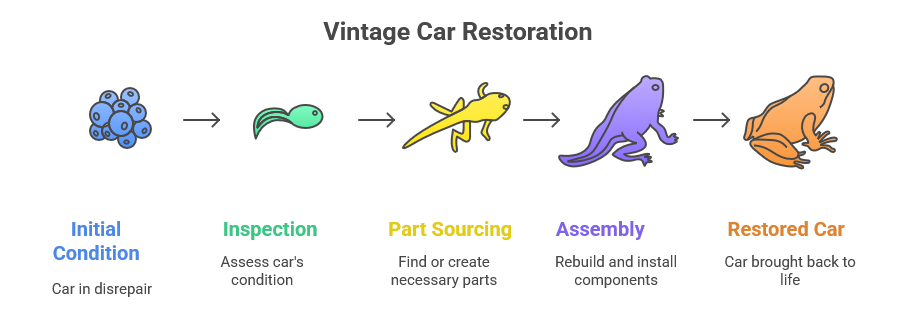
Vintage Car Restoration: From Basics to Full Overhaul
Restoring a vintage car is exciting but can also be overwhelming. It’s more than just fixing a car; it’s about bringing history back to life. There are different levels of restoration based on how you plan to use the car. Here’s what you need to know.
Levels of Restoration: Driver, Street Show, Show Car, and Concourse
- Driver: This level is all about getting the car roadworthy. It’s practical, not perfect. A driver car is for people who want to enjoy their vintage car but don’t need it to be flawless.
- Street Show: A step up from a driver car, this restoration aims for looks but still keeps it practical. It’s perfect for local car shows.
- Show Car: This car is restored to look like it just rolled off the factory floor. Every detail matters here, from paint to trim.
- Concourse: The highest level. Everything is perfect—no flaws allowed. These cars are often seen in competitions, where every detail is judged.
I’ve worked on cars at every level. Each one presents its own challenges, but seeing a car restored is always rewarding.
The Restoration Process: Inspection, Part Sourcing, and Assembly
Restoration starts with an inspection. This is when we check the body, engine, suspension, and other parts. You need to know what can be saved and what must be replaced.
The next step is part sourcing. Some parts are easy to find; others take time. Original parts are best, but sometimes we need to custom-make them. For example, I once restored a 1967 Camaro and had to find rare engine parts. It took some time, but it was worth it.
Finally, comes assembly. This is when everything comes together. Rebuilding the engine, fixing the body, and installing new parts. I’ve seen cars go from rusty and old to shiny and new. Watching that transformation is one of the best parts of the job.
Expanding Beyond Body Work: Mechanical Parts Matter, Too
A lot of restorations focus on bodywork, but mechanical parts are just as important. I remember working on a 1969 Corvette. The body was in good shape, but the engine and brakes were outdated. We rebuilt the engine and swapped in modern disc brakes. It made the car safer to drive and more valuable.
When restoring a car, it’s not just about how it looks—it’s about how it runs, too.
Anecdote: The Value Boost from a Full Restoration
One of the best stories I have is about a 1967 Mustang. The car was in poor condition when it came in. But after a full restoration, we saw its value jump by 50%. We rebuilt the engine, restored the body, and repainted it. The owner was thrilled with the result. And so was I. It reminded me of how much a good auto restoration can boost the value of a car.
How to Find a Good Mechanic for Your Old Car
Your old car is special. It is a piece of the past. You need to find a good car shop.
A good shop will care for your car. A bad shop can cause big problems. It can cost you a lot of money.
I will help you find the best shop for your car. Here are my steps to choose the right one.
Part 1: Look Online First
You should start your search at home. Use your computer to look for shops.
Step 1: Find an expert. You want a shop that loves old cars. A normal shop is not the best choice. Look at their site online. Do they show lots of old cars? Do they work on many kinds of cars? This is a very good sign.
Step 2: Read what people say. Look for reviews online. Do not just look at the stars. Read the full review. Did the shop talk to the owner a lot? Did they stick to the price? Good reviews say more than “they fixed it.” They say “they kept me in the loop.”
Step 3: Look at their skills. Some shops have awards. This is nice to see. But long years of work are key. For old cars, real skill is the best thing. I trust long years of work more.
Part 2: Go to the Shop
Now you have a short list of shops. It is time to visit them.
Step 4: Go see the shop and trust your gut. How does the place feel? It does not need to be super clean. But it should be neat. Are there other old cars there? That is a great sign. It means other owners trust this shop. Do the people there seem happy to see you? Or do they act mad? Trust your gut feel.
Step 5: You need to ask things. Do not be shy. This is a big deal. Here are some good things to ask:
- “Have you worked on a car like mine?”
- “How do you find car parts?”
- “How will you tell me if the cost goes up?”
- “Can I see a car you are working on now?”
- “Can I come see my car while you work?”
Step 6: Ask how they get parts. This is a very key thing to ask.
- Good Sign: “We know lots of people who sell parts. We can even make some parts here.”
- Bad Sign: “We just buy the cheap parts online.”
A Good Option: A Mechanic Can Come to You
Some mechanics can come to your home. This is great for small jobs or to check your car. This can save you a lot of time. It helps a lot if your car can’t drive.
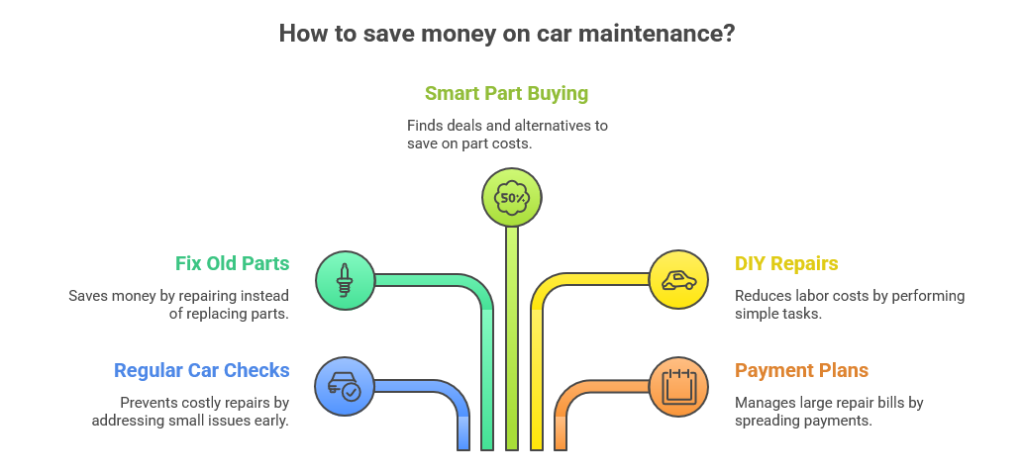
How to Keep Your Classic Car Dream from Becoming a Financial Nightmare
Owning a classic car is a passion, but it doesn’t have to drain your bank account. The secret to affordable auto repair for classic cars isn’t about cutting corners—it’s about being smart. It’s about knowing where to invest your money and how to prevent small issues from becoming major expenses.
See Where Your Money Goes
Let’s see where the money goes. Two things cost the most in car repair.
1. The Price of Parts
The price of parts can change a lot. A Ford Mustang part may be cheap. A part for a rare car can cost a lot of cash. You have to choose what to buy. You can buy new parts from the car maker. You can buy good copy parts. You can also find good used parts. Your choice will set your total cost.
2. The Price of Work
Good work costs money. A good car pro knows a lot about old cars. He may charge a lot for each hour of work. But he does the job right the first time. This saves you money in the long run. A good pro is worth the cost.
My Top 5 Tips to Save Money
With that in mind, here are my top five tips. They will help you keep your costs low.
1. Check Your Car a Lot
This is the best way to save. Fix small things now. Big problems cost a lot more to fix. I have seen big engine work that began with just a small oil leak.
- Check fluids each week. Old oil is bad for your car’s heart. Check oil. Check brake fluid. Check cool water too.
- Look at belts and hoses. A bad belt can stop your car. This can make the car get too hot. It is cheap to fix them now.
- Check your brakes. Bad brake pads are not safe. They can harm other expensive parts. If you hear a loud sound, get your brakes checked.
- Clean the fuel mixer. Your car may have a part that mixes fuel and air. Keep it clean. A clean one works well. This can save you from a big fix later.
- Care for your tires. Check the air in your tires. The right amount of air makes them last long. It is also safer to drive.
2. Fix Parts, Don’t Always Buy New
Shops today like to swap old parts for new ones. With old cars, it is often smart to fix the old part. This keeps your car true to its past. Here is a true story. A man had a 1965 Mustang. He was told a new fuel mixer was $500. We did not buy it. We took the old one apart. We cleaned it. We put it back. It worked like new and cost him way less money.
3. Be Smart When You Buy Parts
Do not buy the first part you see. Look for deals online. Ask car clubs for help. Your car pro may know where to find good used parts. For some things, a good copy part works just fine. It can save you a lot of cash.
4. Know What You Can Fix
You can do small jobs on your own. You can save money this way. You can change the oil. You can change the air filter. These are good jobs for you to do. But know when to stop. Hard jobs need a pro. Let a pro fix brakes or wires. This will stop you from making big mistakes.
5. Ask for a Payment Plan
A big car fix can cost a lot at one time. You can ask the shop for help. Many good shops let you pay over time. This makes big bills easy to handle. Do not be afraid to ask.
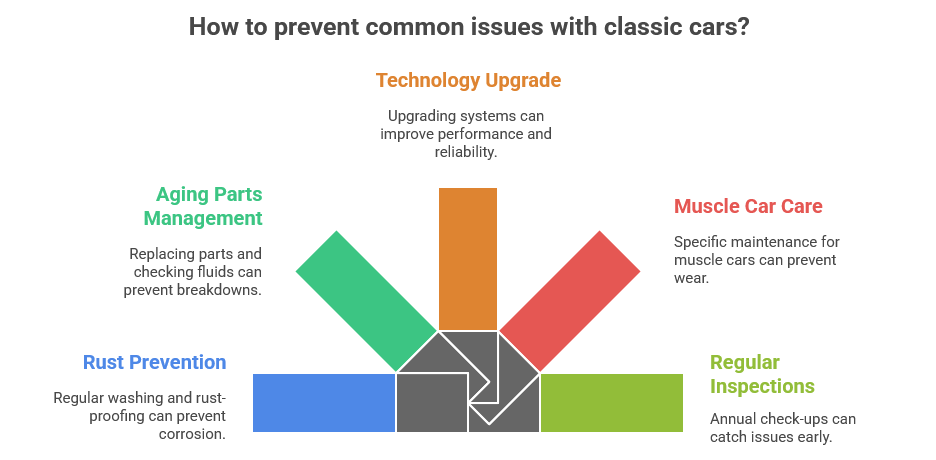
Common Issues with Classic Cars and How to Prevent Them
Owning a classic car is a lot of fun, but it also comes with some challenges. Rust, aging parts, and outdated technology are common problems many owners face. The good news is, you can prevent most of these issues with the right care. Let’s dive into the most common problems and how to fix them.
1. Rust and Corrosion
Rust is one of the biggest enemies of classic cars. Over time, moisture can get into the metal parts and cause corrosion. This is especially bad for cars that have spent years in rainy or snowy areas.
How to prevent it:
- Regular washing: Keep your car clean to remove salt and dirt that can cause rust.
- Check for rust spots: Look under the car and around the wheels for any signs of rust.
- Rust-proofing: You can treat the car’s undercarriage with rust-proofing sprays to stop rust from spreading.
I once worked on a 1968 Mustang where rust spread from a small spot in the floor. If we had caught it earlier, we could’ve saved the owner a lot of money.
2. Aging Parts
Over time, rubber parts like hoses, belts, and seals wear out. These can crack or break, causing leaks or engine problems.
How to prevent it:
- Replace rubber parts regularly: Even if they look fine, replace these parts every few years.
- Check fluids: Low fluid levels can lead to engine damage. Keep an eye on oil, coolant, and brake fluid.
- Have spare parts: It’s smart to keep a few extra hoses or belts on hand for emergencies.
A customer once brought in a 1970 Chevelle with a snapped belt. It caused an engine breakdown on the highway. Replacing belts earlier could’ve avoided the situation.
3. Outdated Technology
Many classic cars still use carburetors, points ignition, and older electrical systems. These parts can be difficult to maintain and more likely to break down.
How to prevent it:
- Upgrade when needed: Consider switching to electronic ignition or fuel injection for better performance and reliability.
- Regular cleaning: Clean the carburetor often to keep it from clogging.
- Use the right fuel: Some classic cars need special fuel. Make sure you’re using the correct type.
For a 1969 Camaro, I rebuilt the carburetor and upgraded the ignition system. It ran much smoother after that.
4. Muscle Car Repair and Specific Models
If you own a muscle car, you might face more wear on suspension systems, brakes, and transmissions. These cars were built for power and can wear out quickly if not properly maintained.
How to prevent it:
- Check suspension and brakes: These parts bear the brunt of the car’s power. Make sure they’re in top condition.
- Change transmission fluid: Regularly change the fluid to keep the gears working smoothly.
- Inspect powertrain parts: Muscle cars with upgraded engines need extra care in the drivetrain.
I worked on a 1970 Dodge Charger where the transmission started slipping. Regular maintenance would have caught that issue before it became a big problem.
5. The Importance of Regular Inspections
Regular inspections are key to keeping your classic car in good shape. Small problems can turn into big ones if they’re ignored.
How to prevent it:
- Schedule check-ups: Have your car inspected at least once a year to catch any issues early.
- Keep a repair log: Write down any repairs you’ve had done. This will help you stay on top of what needs attention.
For muscle car repair, regular inspections are even more important. These cars need more care because of the power they generate.
Classic Cars in Temecula: Local Auto Repair Resources
If you own a classic car in Temecula, you’re lucky. The city has several great repair shops that specialize in classic car repair and restoration. Whether you need a muscle car repair or a full vintage auto restoration, these shops have the experience to get your car running like new. Here are a few of the best options.
1. Temecula Valley Auto Repair and Restoration
Temecula Valley Auto Repair and Restoration is known for its excellent work on classic cars. They offer services like engine rebuilds, body restoration, and vintage car painting. What sets them apart is their attention to detail. They really know how to preserve the authenticity of each car.
They also specialize in vintage motorsports prep. If you’re preparing for a race or event, they’ll help tune your car for maximum performance. Their team has experience with all kinds of classic cars, making them a great choice for muscle car repair as well.
2. Classic Car Care of Temecula
Another great option is Classic Car Care of Temecula. This shop offers a full range of auto restoration services, from brake services to suspension work and carburetor rebuilds. They focus on both the mechanical and aesthetic aspects of restoration. Whether you need to restore the engine or repaint the body, this shop does it all.
What makes them stand out is their work with vintage motorsports prep. They’ve helped get cars ready for big shows and races, ensuring they’re not only beautiful but also perform at their best.
3. The Muscle Car Garage
For muscle car enthusiasts, The Muscle Car Garage is a must-visit. They specialize in muscle car repair and restoration. Whether it’s engine restoration, brake upgrades, or exhaust system repairs, they know how to handle high-performance vehicles.
What’s special about this shop is their focus on performance upgrades. They don’t just restore cars to their original condition—they make them run better. If you’re into vintage motorsports or want to boost your car’s power, this shop is perfect for you.
4. Temecula Auto Restoration
Temecula Auto Restoration is known for its quality work and passion for vintage auto restoration. They offer complete restoration services, from bodywork to engine repair. They also provide expert vintage car painting and custom auto body work.
They’re especially focused on keeping the car’s original look and feel intact. Whether you need a classic car engine repair or a complete overhaul, they can make sure your car stays authentic while running at its best.
Why Temecula?
Temecula is an amazing place for classic car owners. The town has a growing car culture and plenty of shops that specialize in classic car repairs and restorations. Whether you want to restore your car for shows, vintage motorsports, or just enjoy it on the road, you’ll find the right expert here.
Cost of Classic Car Repairs – What to Expect
Owning a classic car is a dream, but the cost of repairs and restoration can add up. Understanding what affects the price can help you plan better. Here’s a look at the factors that influence costs and how to manage them.
Factors Affecting Cost
- Rarity of Parts
Parts for classic cars can be hard to find. If the part is rare, it can cost a lot. For example, finding an old carburetor or a vintage engine part can be pricey. Rare parts often need to be custom-made, which adds to the cost. - Extent of Body Damage
If your car has body damage, it can get expensive to fix. Major damage, like rust or dents, requires more labor and materials. Body repairs can cost anywhere from $100 to $200 per hour for labor. The more damage, the higher the price. - Imported Materials
Some cars need parts from other countries. This means shipping costs, taxes, and sometimes long waits. If your classic car is European, you might have to import parts, which can add to the overall cost. - Custom Work
Custom work like performance upgrades or fabricating parts can be expensive. Custom exhaust systems, interior work, and engine modifications all require skilled labor and special materials, which increases the cost.
Affordable Auto Repair for Classic Cars – Balancing Cost and Quality
It’s important to balance cost and quality when it comes to classic car repair. Here’s a simple guide on how to save money while still getting good results:
| Service | Affordable Option | When to Invest in Quality |
|---|---|---|
| Engine Repairs | Use remanufactured parts when possible | Original parts for better engine performance |
| Bodywork and Paint | DIY for minor touch-ups or rust spots | Professional work for major body damage |
| Carburetor Rebuild | Rebuild it yourself with a kit | Professional rebuild for rare or high-performance carburetors |
| Suspension Repairs | Aftermarket suspension parts | Custom suspension for better handling and performance |
| Interior Restoration | Use standard materials for reupholstering | Custom upholstery for show-quality restorations |
| Brake System | Aftermarket brake pads and rotors | Original or performance brake systems for safety and reliability |
Pro Tips on Budgeting for Restoration vs. Maintenance
- Focus on Essential Repairs First
When restoring a classic car, start with the essentials. Get the engine and brakes working well before worrying about cosmetics like bodywork or paint. These are critical for safety and performance. - Budget for Regular Maintenance
Classic cars need regular care. Oil changes, brake checks, and carburetor cleaning should be done yearly. These small tasks prevent bigger problems and help you avoid costly repairs. - Set Aside Extra Funds
Unexpected issues often arise during restorations. Always keep some extra money aside—around 10-20% of your budget—to handle surprises. It’s better to be prepared than shocked by hidden costs. - Spread Out Costs
You don’t have to do everything at once. Break your restoration into phases. One year, focus on the engine; the next, tackle the bodywork. This helps spread out the cost over time. - Use Financing Options
Many repair shops offer financing plans, like NAPA EasyPay. This lets you pay in installments instead of all at once. It can help make big restorations more affordable without putting too much strain on your finances.
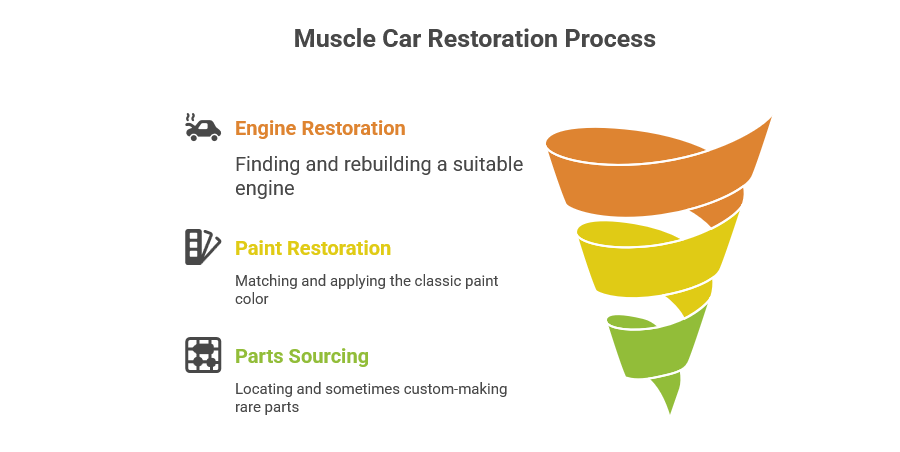
Case Studies & Personal Experiences
Restoring a classic car is always a rewarding experience. It’s more than just fixing a car; it’s about bringing it back to life. Here’s one of my favorite stories that shows what goes into a restoration.
Muscle Car Restoration: Engine, Paint, and Parts Sourcing Challenges
A few years ago, I worked on a 1969 Pontiac GTO for a client. The car had been sitting in a garage for over ten years. It was in rough shape: the engine was dead, the body was rusty, and the paint was peeling. The owner had big dreams of bringing this muscle car back to life.
The first challenge was the engine. The original engine couldn’t be saved, so we had to find a new one. Sourcing parts for a 1969 GTO was tough. We found a rebuilt engine, but getting the right parts to match the original specs was a challenge. It took time, but we managed to rebuild the engine and add a modern ignition system to make it more reliable.
Next, the paint. The body needed a lot of work. We had to remove the rust, fix dents, and smooth out the surface. Finding the right paint color was tricky. The car needed that classic Royal Bobcat Blue, so I worked closely with a painter to match the color perfectly.
The hardest part was parts sourcing. Some parts were hard to find, and we had to track down different suppliers. Some parts were so rare that we had to make custom pieces. That added extra time and cost, but the result was worth it.
When the car was finally ready, the owner couldn’t believe his eyes. He was thrilled to see his GTO looking and running like new again. It was a true muscle car once more, with that same roar and power it had when it was first built.
This project was special because it wasn’t just about fixing the car. It was about keeping its spirit alive while making sure it was safe and reliable. Restoring muscle cars takes patience, but when you see the finished product, it’s always worth it.
Frequently Asked Questions (FAQs)
How much does a full classic car restoration cost?
A full classic car restoration can cost anywhere from $10,000 to $100,000+, depending on the car’s condition and the level of restoration. The price can vary based on factors like engine repair, bodywork, and part sourcing. Keep in mind, the rarer the car, the higher the cost.
Will mechanics work on classic cars?
Yes, many mechanics specialize in classic car repair. However, not all shops have the expertise to handle vintage vehicles. It’s best to find a shop experienced with auto restoration and vintage car maintenance. They should know how to work on older engines, carburetors, and other classic car parts.
What is the 30-60-90 rule for cars?
The 30-60-90 rule is a guideline for car maintenance. At 30,000 miles, you should check the brakes, fluids, and tires. At 60,000 miles, it’s time for engine inspections and belt replacements. At 90,000 miles, you may need a timing belt change and a full inspection of major car systems.
Is it cheaper to buy a new car or fix an old car?
It depends on the car’s condition and the needed repairs. If your classic car needs major work like engine rebuilds or body restoration, it could be more expensive than buying a new car. However, if the car is in good shape, repairing an old car may be cheaper and allow you to keep a valuable, vintage vehicle.
What is the difference between antique car maintenance and modern cars?
Antique car maintenance requires special care since older cars have carburetors, older electrical systems, and mechanical parts that are harder to replace. Modern cars are more automated, with fuel injection and digital systems. Maintaining a classic car often involves sourcing rare parts and careful, hands-on work.
My Final Thoughts on Auto Repair for Classic Cars
Your classic car is more than a machine; it’s a rolling piece of history, and you are its caretaker. Proper auto repair for classic cars is about protecting that legacy through proactive maintenance and expert guidance. Schedule a professional inspection today—it’s the smartest investment you can make in your car’s future and your own peace of mind.
